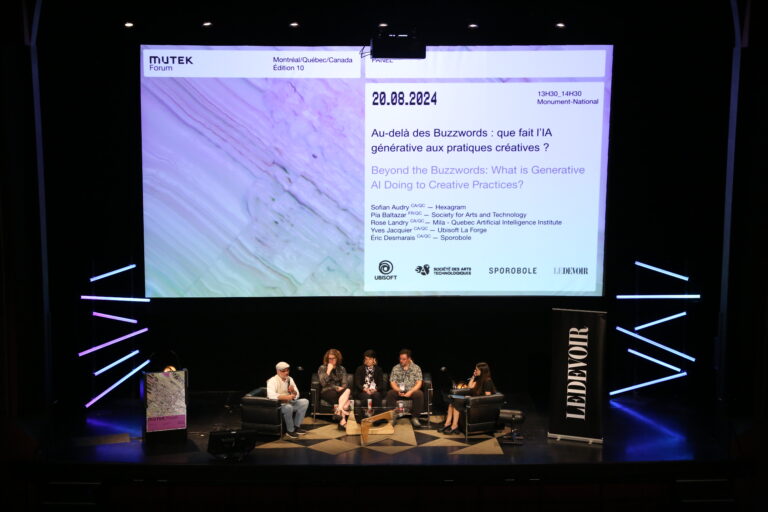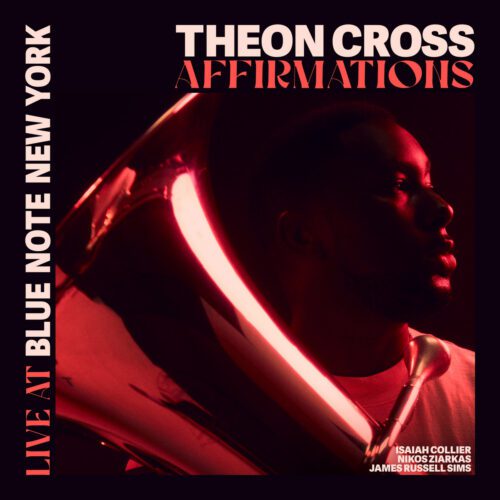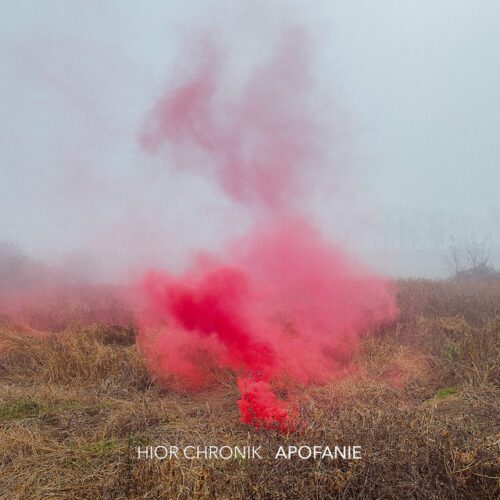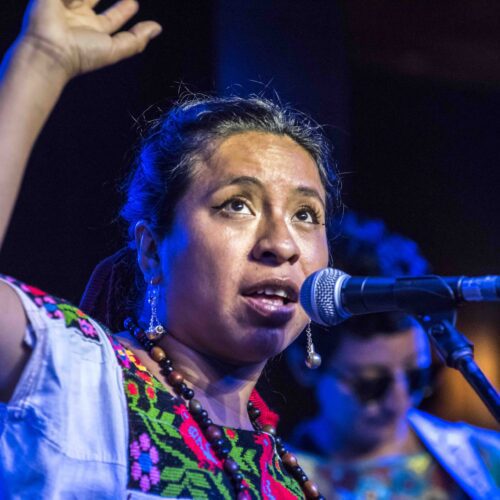On August 20, 2024, during the MUTEK Forum, a panel entitled “Beyond Buzzwords: what does generative AI do to creative practices?” was held at the Monument-National, bringing together experts from diverse backgrounds to explore the impact of generative AI on artistic practices. Moderated by Mila’s Rose Landry, the panel included Sofian Andry (Hexagram), Pía Balthazar (SAT), Yves Jacquier (Ubisoft), and Éric Desmarais (Sporobole).
Yves Jacquier opened the discussion with a look at the integration of AI in the video game industry, pointing out that AI – a 70-year-old term – has gradually become an integral part of video game production. He highlighted the importance of an interdisciplinary approach involving designers, programmers and artists to exploit these technologies ethically and effectively.
Pía Balthazar shared his experience at SAT, where the development of arts and sciences is carried out in partnership with artistic and academic communities. SAT and Sporobole are working on a project that aims to understand how machine learning tools can serve artists rather than constrain them. By mobilizing the notion of the imaginary and taking artists’ practices as a starting point, the aim is also to deconstruct the techno-deterministic, fear-filled discourse that surrounds these technologies.
Sofian Andry brought a historical perspective from his book Art in the Age of Machine Learning, published by MIT Press. In it, he traces the origins of art and science in the age of machine learning, focusing on a material analysis of machine learning models. He explores what constitutes a machine learning model and examines how some artists have appropriated these mechanisms, bringing them closer to practices such as genetic algorithms and data-driven approaches, opening up new perspectives in artistic creation.
Éric Desmarais discussed the evolution of artistic practices within Sporobole, notably through creation and applied research cycles, during which artists experiment with different technologies. Pre-pandemic, the cycle focused on virtual universes. In 2021, as the cycle drew to a close, the ChatGPT wave broke, bringing to light a whole host of generative AI tools. The AI cycle enables artists to experiment, create works and, through this research process, develop a strong artistic voice for independent artists.
This brings us to the heart of what we’re interested in when we talk about generative AI and buzzwords: are these technologies really disruptive? Is it a paradigm shift, or rather the arrival of a new tool? Pía Balthazar noted that this tsunami-like “violent” change had been in the pipeline for some time, while Yves Jacquier confirmed that there is a real disruption underway, with the arrival of new players, the transformation of structures and the evolution of working methods.
The panel also raised the question – which must be central – of the value of works created by generative AI. Sofian Andry reminded us that while AI can produce novelty, the value of this novelty remains a complex issue. Culture is human, and a system disconnected from the world, disembodied, cannot understand or “be” in culture. Éric Desmarais, joined by other panel members, pointed out that, with AI, the value of the work/production shifts from the result to the concept, unlike the work of an illustrator, where it’s the result that takes precedence.
Nevertheless, optimism is the order of the day: we need to take advantage of the momentum to rebalance power and value throughout the artistic ecosystem. The best ways to achieve this are to encourage interdisciplinarity, as Ubisoft and SAT are doing, and not to underestimate the power and agentivity of local businesses, because not all important decisions are made in Silicon Valley.
Photo credit: Maryse Boyce
























